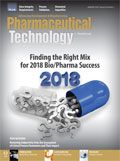Pharma Equipment Gets Smart
The Industrial Internet of Things can be used in the bio/pharmaceutical industry to monitor equipment health, optimize processes, and enable modular facilities.
Africa Studio/Shutterstock.com

The Industrial Internet of Things (IIoT) involves connecting “things” (i.e., equipment) through the Internet. “Smart” equipment uses sensors to provide data for improving a process or monitoring equipment health, for example.
“The IIoT brings new options to the table for collecting data from the process and sending it to manufacturing execution systems and distributed control systems (DCS),” explains Greg Newman, vice-president of Marketing at Parsec Automation Corp. “IIoT devices on the plant floor are being used to reduce the investment in infrastructure and setup time for simple data collection tasks, such as production counters, temperature measurement, and equipment state. IIoT devices can also more easily enable sending these data off-site to remote data-capture software.”
Predictive maintenance
Manufacturing companies from different industries are relying on data analytics, with data collected by the IIoT, to solve problems related to unscheduled downtime, a survey conducted in 2016 by Honeywell found (1). Although pharma manufacturing is different from other manufacturing sectors in its focus on regulatory compliance and in the types of equipment being used, the ultimate aim to prevent downtime and improve reliability still applies. “Manufacturers want to produce high quality products, and they don’t want to lose batches. Monitoring equipment and process data is crucial to achieve this goal,” notes Matthias Maaz, director of Pharma and Specialty Chemicals, Honeywell Process Solution.
“Predictive maintenance might be the killer app for IIoT,” says Petter Mörée, industry principal for Life Science, Food and Beverage, Chemical at software supplier OSIsoft. Mörée reports that one pharma company using remote monitoring of real-time data had reduced unplanned downtime at a facility because it could more closely monitor conditions such as temperature and humidity, and calibrate systems more accurately.
“Continuously collecting real-time data from the operating equipment and machines, and then analyzing these data to harness and deliver actionable insights related to asset utilization will help with failure prediction and can improve uptime in all the machines across the plant,” says Billy Sisk, Life Sciences Industry manager for EMEA at Rockwell Automation. He says that although predictive maintenance isn’t a new concept, more data can now be captured, and the cost of computing and data storage is now lower. “One of the key values of scalable analytics is the ability to leverage all the data gathered from the shop-floor equipment and analyze it to improve plant and asset performance. For instance, pharmaceutical producers can monitor performance at an equipment or system level, and track what assets are failing more frequently or are degrading. This information can be used to develop a comprehensive maintenance and predictive asset-management program.”
Troubleshooting is also enhanced. For example, reports Sisk, a biopharmaceutical company that was upgrading to new purification skids added monitoring of the skids’ variable frequency drives (VFDs). “The VFD fault codes are reported to the programmable logic controller (PLC) and collected in a data historian. The company said using such monitoring saved a day’s worth of troubleshooting in just the first week. The new skids also support workers who want remote access from the office or another location, which provides the ability to begin troubleshooting in mere minutes.”
Another example of an IIoT-enabled device is the i-ALERT2 Bluetooth Smart monitor from ITT. The monitor tracks pump vibration, temperature, and run-time hours, and the data are sent wirelessly to cloud storage for analysis of equipment health. Guidance can then be sent to the operators to schedule regular maintenance, and the system can alert operators of problems so they can take action to prevent equipment failure.
Process optimization
Equipment performance is directly affected by process performance, and overall production reliability is intertwined with overall equipment effectiveness (OEE), says Edwin van Dijk, vice-president of Marketing at TrendMiner, a company offering self-service industrial analytics software. He says that “contextualizing asset performance with process data” is crucial, and that a better understanding of the connection of the equipment and process will enable improved reliability and control of product quality and efficiency.
Manufacturing process data tied to the process (i.e., time-series data) are valuable when presented graphically to subject-matter experts, says van Dijk. He explains that process engineers can use the advanced analytics software to search the historian for similar behavior in the past and graphically overlay the performance patterns. “In correlation with behavior of other tags, these comparisons may indicate root causes for anomalies,” says van Dijk. “On the other hand, in case of good behavior, the patterns of multiple periods of preferred behavior can be combined into golden fingerprints for batch or continuous production. Actual production can then be monitored against the golden fingerprint, even remotely.”
Smaller batches, such as those used in personalized medicine, can be more difficult to optimize for process efficiency and reliability. Analyzing the data collected through the IIoT, however, enables optimization. “Data analytics by subject matter experts thus becomes more important, and they need tools to quickly analyze, monitor, and predict process and asset performance,” says van Dijk.
The IIoT allows producers to more accurately monitor production, which enables personalized batches, adds Mörée. Consistency and reliability are crucial for reducing product losses no matter what the batch size is. Using data analysis to catch problems early, or even prevent them, will be one of the major trends over the next several years, says Mörée. He reports that one of OSIsoft’s biopharma users is using IIoT technology to monitor and correct deviations in a fermentation process to reduce the inherent variability in the process. “In a traditional production environment, you may not be aware of deviations until two days into the process. This manufacturer expects to triple its yields by better monitoring,” reports Mörée.
Enabling modular pharma facilities
Modular, “plug-and-play” equipment is increasingly being used, and bio/pharma manufacturing that uses skid-mounted, moveable, and modular equipment can particularly benefit from IIoT solutions, adds Chris Morse, technical solution consultant at Honeywell Process Solutions. “With the IIoT, you can connect a piece of mobile equipment and the system automatically identifies the equipment and knows information such as its cleanliness status. The IIoT simplifies configuration and prevents connection errors.”
The IIoT can optimize manufacturing processes that use single-use equipment, which require equipment tracking, flow-path verification, material tracking, and hygienic status tracking, says Sisk. In the facility of the future, he envisions that “workers will move assets such as mobile mixing tanks and smart totes into and out of production areas. A modern DCS can coordinate this movement, including verifying the right asset is in the right place, executing production processes, releasing equipment modules, and disabling display information after a process is complete. Mobile tablets or screens on wheels will be able to go with operators as they follow production from one process area to another.”
Remote monitoring
The IIoT is built around sending data from the plant floor to “remote” locations, whether these locations are a few feet away in the facility control room or many miles away at a location where specialists can analyze the data. Pharma manufacturers are typically leery of the concept of remote monitoring, says Maaz, because they don’t want equipment manufacturers to have direct access to their DCS and to sensitive data. “Remote,” however, could also mean that a pharma manufacturer’s engineers have a secured line of information from the process at their desktop or mobile device, or that the maintenance person outside of the cleanroom can have access to data at the same time as the operator inside of the cleanroom, explains Maaz. “The ‘mobile operator’ can be in the area but not directly at the equipment monitor. They can carry a mobile human-machine interface (HMI) that can alert them when a disturbance may have occurred,” he adds.
“Decision making in pharma manufacturing is not just by the operator,” says Maaz. “The operator, quality assurance personnel, management, and regulatory compliance personnel also want access to data. An IIoT platform is flexible and enables everyone to be involved in complex decisions.” In addition to data access, data configuration is important. For the operators, for example, the HMI should present information “in a way that they can use it, so they can react to a disturbance, for example, or be reminded what process step is coming up next so they can prepare for it,” explains Maaz.
It can also be valuable for remote access to be given to an equipment manufacturer to look at a specific issue. This access, which could be enabled and then disabled again, would be limited to specific instances under high security, adds Morse.
Another potential use of remote monitoring is that pharma companies may be able to use IIoT technology to remotely monitor and track production at a contract manufacturing organization, enabling them to ensure data integrity and optimize production at different sites, says Mörée.
Security challenges
Securing IIoT devices is a significant concern. “There are many facets, including isolating the interference that a rough data collection device could cause, to the overall network exposure as the devices are opened up to the public internet,” notes Newman. Although the ability for remotely located software solutions, either in the cloud or in central private data centers, is a significant potential benefit for pharma manufacturing, the biggest barriers to using such solutions, Newman says, are “reliable remote connections and network infrastructure, as well as organizational maturity in setting up risk-acceptable security around the implementations.”
Additional connections can create more potential entrance points for threats, adds Sisk. “Pharma producers should adopt a defense-in-depth security approach, which deploys multiple layers of protection, assuming that any one protection point can and likely will be defeated. Some security measures that pharma producers should use as part of a defense-in-depth strategy include anomaly-detection software, AAA [authentication, authorization, and accounting] software, and an industrial ‘demilitarized zone’.”
A survey sponsored by Honeywell found that industrial companies, in general, are lacking in their adoption of cyber-security measures. “To take advantage of the tremendous benefits of industrial digital transformation and IIoT, companies must improve their cyber-security defenses and adapt to the heightened threat landscape now,” said Jeff Zindel, vice-president and general manager, Honeywell Industrial Cyber Security, in a press release (2).
References
1. Honeywell, “Survey Finds Manufacturing Executives Will Prioritize Big Data Investments to Solve Problems,” Press Release, Sept. 13, 2016.
2. Honeywell, “Honeywell Survey Shows Low Adoption of Industrial Cyber Security Measures,” Press Release, Dec. 6, 2017.
Article Details
Pharmaceutical Technology
Vol. 42, No. 1
January 2018
Pages: 40–43
Citation
When referring to this article, please cite it as J. Markarian, "Pharma Equipment Gets Smart," Pharmaceutical Technology 42 (1) 2018.
About the author
Jennifer Markarian is manufacturing editor for Pharmaceutical Technology.

Drug Solutions Podcast: A Closer Look at mRNA in Oncology and Vaccines
April 30th 2024In this episode fo the Drug Solutions Podcast, etherna’s vice-president of Technology and Innovation, Stefaan De Koker, discusses the merits and challenges of using mRNA as the foundation for therapeutics in oncology as well as for vaccines.
Entering New Domains for 3D Printing of Drug Products
April 6th 20253D printing of personalized medications is currently possible under existing compounding regulations, offering enhanced process control through automation. But new legislation coming in 2025 will allow 3D printing as part of a distributed manufacturing framework.